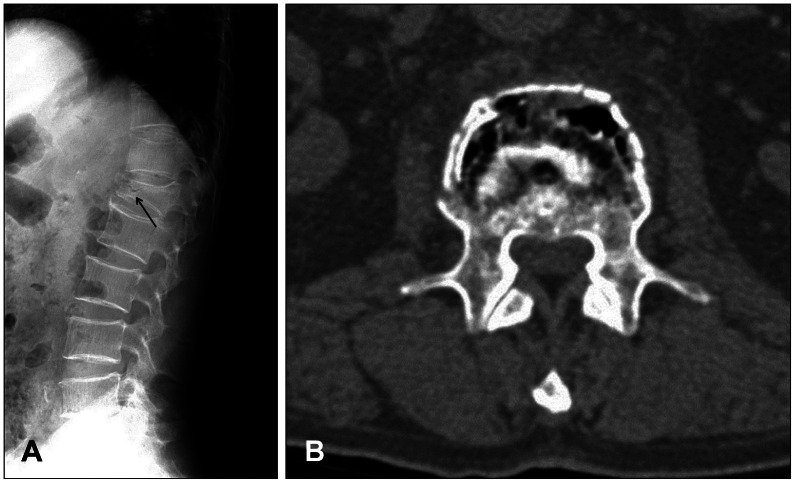Korean J Neurotrauma.
2016 Apr;12(1):18-21. 10.13004/kjnt.2016.12.1.18.
Gradual Height Decrease of Augmented Vertebrae after Vertebroplasty at the Thoracolumbar Junction
- Affiliations
-
- 1Department of Neurosurgery, VHS Medical Center, Seoul, Korea. euro3399@naver.com
- KMID: 2163010
- DOI: http://doi.org/10.13004/kjnt.2016.12.1.18
Abstract
OBJECTIVE
Vertebroplasty is an effective treatment for vertebral compression fracture, but may progress gradual vertebral height decrease in spite of vertebroplasty. Gradual vertebral height decrease also may induce aggravation of kyphotic change without severe pain. The purpose of this study was to evaluate risk factors for gradual vertebral height decrease in the absence of recurrent severe back pain.
METHODS
A retrospective analysis was performed on 44 patients who were diagnosed with a first osteoporotic compression fracture at a single level at the thoracolumbar junction. All patients were taken vertebroplasty. Possible risk factors for gradual vertebral height decrease, such as sex, age, bone mineral density, body mass index, level of compression fracture, volume of injected cement, cement leakage into disc space, and air clefts within fractured vertebrae, were analyzed.
RESULTS
Gradual vertebral height decrease of augmented vertebrae occurred commonly when more than 4 cc of injected cement was used, and when air clefts within fractured vertebrae were seen on admission. In addition, the sagittal Cobb angle more commonly increased during the follow-up period in such cases.
CONCLUSION
Injection of more than 4 cc of cement during vertebroplasty and air cleft within fractured vertebrae on admission induced gradual vertebral height decrease in augmented vertebrae. Thus, longer follow-up will be needed in such cases, even when patients do not complain of recurrent severe back pain.
MeSH Terms
Figure
Reference
-
1. Aquarius R, van der Zijden AM, Homminga J, Verdonschot N, Tanck E. Does bone cement in percutaneous vertebroplasty act as a stress riser? Spine (Phila Pa 1976). 2013; 38:2092–2097. PMID: 24026155.
Article2. Chandra RV, Yoo AJ, Hirsch JA. Vertebral augmentation: update on safety, efficacy, cost effectiveness and increased survival? Pain Physician. 2013; 16:309–320. PMID: 23877447.3. Chen LH, Hsieh MK, Liao JC, Lai PL, Niu CC, Fu TS, et al. Repeated percutaneous vertebroplasty for refracture of cemented vertebrae. Arch Orthop Trauma Surg. 2011; 131:927–933. PMID: 21191607.
Article4. Dohm M, Black CM, Dacre A, Tillman JB, Fueredi G. A randomized trial comparing balloon kyphoplasty and vertebroplasty for vertebral compression fractures due to osteoporosis. AJNR Am J Neuroradiol. 2014; 35:2227–2236. PMID: 25300981.
Article5. Frankel BM, Monroe T, Wang C. Percutaneous vertebral augmentation: an elevation in adjacent-level fracture risk in kyphoplasty as compared with vertebroplasty. Spine J. 2007; 7:575–582. PMID: 17905320.
Article6. Heo DH, Chin DK, Yoon YS, Kuh SU. Recollapse of previous vertebral compression fracture after percutaneous vertebroplasty. Osteoporos Int. 2009; 20:473–480. PMID: 18636218.
Article7. Hiwatashi A, Moritani T, Numaguchi Y, Westesson PL. Increase in vertebral body height after vertebroplasty. AJNR Am J Neuroradiol. 2003; 24:185–189. PMID: 12591631.8. Kang SK, Lee CW, Park NK, Kang TW, Lim JW, Cha KY, et al. Predictive risk factors for refracture after percutaneous vertebroplasty. Ann Rehabil Med. 2011; 35:844–851. PMID: 22506213.
Article9. Kim SG, Yang JC, Kim TW, Park KH. Risk factors for subsequent fracture after osteoporotic vertebral compression fracture. Korean J Neurotrauma. 2013; 9:120–124.
Article10. Kim YY, Rhyu KW. Recompression of vertebral body after balloon kyphoplasty for osteoporotic vertebral compression fracture. Eur Spine J. 2010; 19:1907–1912. PMID: 20559850.
Article11. Lewis G. Properties of acrylic bone cement: state of the art review. J Biomed Mater Res. 1997; 38:155–182. PMID: 9178743.
Article12. Li YA, Lin CL, Chang MC, Liu CL, Chen TH, Lai SC. Subsequent vertebral fracture after vertebroplasty: incidence and analysis of risk factors. Spine (Phila Pa 1976). 2012; 37:179–183. PMID: 21240045.13. Lin WC, Lee YC, Lee CH, Kuo YL, Cheng YF, Lui CC, et al. Refractures in cemented vertebrae after percutaneous vertebroplasty: a retrospective analysis. Eur Spine J. 2008; 17:592–599. PMID: 18204942.
Article14. Liu WG, He SC, Deng G, Guo JH, Fang W, Zhu GY, et al. Risk factors for new vertebral fractures after percutaneous vertebroplasty in patients with osteoporosis: a prospective study. J Vasc Interv Radiol. 2012; 23:1143–1149. PMID: 22920978.
Article15. Nagaraja S, Awada HK, Dreher ML, Bouck JT, Gupta S. Effects of vertebroplasty on endplate subsidence in elderly female spines. J Neurosurg Spine. 2015; 22:273–282. PMID: 25525963.
Article16. Oakland RJ, Furtado NR, Wilcox RK, Timothy J, Hall RM. The biomechanical effectiveness of prophylactic vertebroplasty: a dynamic cadaveric study. J Neurosurg Spine. 2008; 8:442–449. PMID: 18447690.
Article17. Piazzolla A, De Giorgi G, Solarino G. Vertebral body recollapse without trauma after kyphoplasty with calcium phosphate cement. Musculoskelet Surg. 2011; 95:141–145. PMID: 21468725.
Article18. Pneumaticos SG, Triantafyllopoulos GK, Evangelopoulos DS, Hipp JA, Heggeness MH. Effect of vertebroplasty on the compressive strength of vertebral bodies. Spine J. 2013; 13:1921–1927. PMID: 23981817.
Article19. Stańzyk M, van Rietbergen B. Thermal analysis of bone cement polymerisation at the cement-bone interface. J Biomech. 2004; 37:1803–1810. PMID: 15519587.20. Syed MI, Patel NA, Jan S, Harron MS, Morar K, Shaikh A. Intradiskal extravasation with low-volume cement filling in percutaneous vertebroplasty. AJNR Am J Neuroradiol. 2005; 26:2397–2401. PMID: 16219853.21. Wagner AL, Baskurt E. Refracture with cement extrusion following percutaneous vertebroplasty of a large interbody cleft. AJNR Am J Neuroradiol. 2006; 27:230–231. PMID: 16418390.
- Full Text Links
- Actions
-
Cited
- CITED
-
- Close
- Share
- Similar articles
-
- Radiological Follow-up Results of Cemented Vertebrae after Vertebroplasty
- Vertebral Body Height Restoration after Vertebroplasty in Osteoporotic Vertebral Fracture
- Percutaneous Vertebroplasty: Short-term Results of 38 Cases
- Unpredictable Spontaneous Fusion after Percutaneous Vertebroplasty and Kyphoplasty in Osteoporotic Compression Fracture
- Vertebral Recompression after Vertebroplasty or Kyphoplasty


